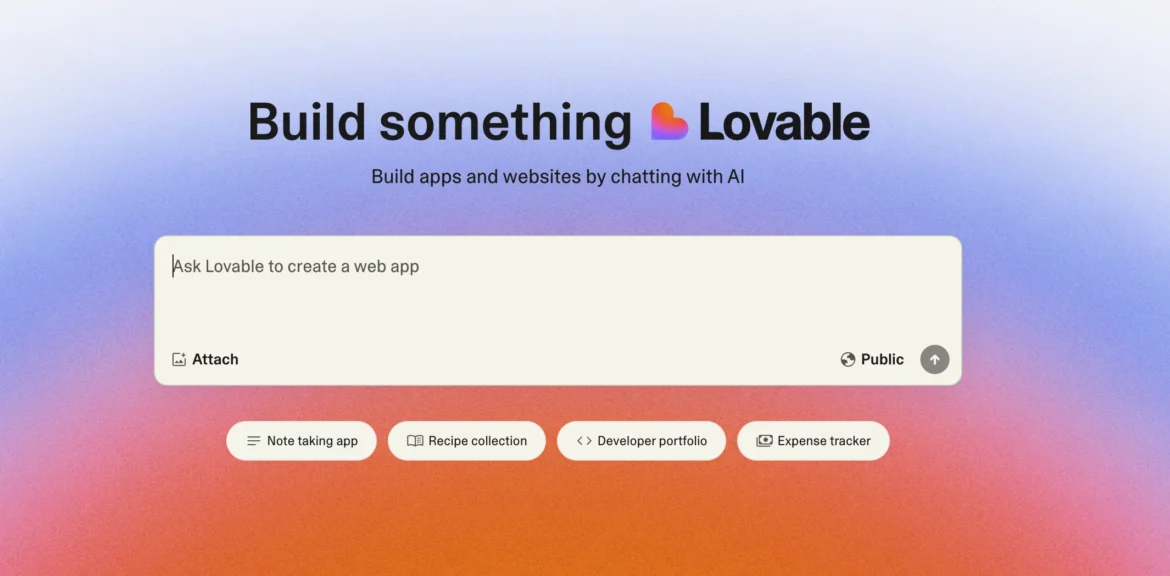
Lovable AI
What is Lovable AI?
Lovable AI functions as a “personal full-stack engineer,” transforming ideas into functional applications in seconds or minutes. Users simply describe their desired app or feature in plain English (e.g., “Create a blog platform with user authentication and a comment section”), and the AI generates the necessary code for the front-end, back-end, and database setup.
Key Features and Functionality:
- Security Scan: Lovable includes a security scan feature, particularly when connected to Supabase, to help identify potential vulnerabilities.
- Full-Stack Development: Lovable handles both client-side (user interface) and server-side (logic, database connections) code generation, providing a complete application. It often generates front-ends using React + Tailwind CSS with Vite.
- Integrated Backend Services: It features deep integration with services like Supabase, automatically configuring databases (PostgreSQL), user authentication, real-time data updates, and file handling.
- GitHub Integration and Code Ownership: A crucial advantage is that users retain full ownership of the generated code. Lovable syncs with GitHub, allowing users to manage, version control, and collaborate on their codebases. The code can also be exported for further customization in any code editor, avoiding vendor lock-in.
- Real-time Preview and Visual Editing: Users can see changes instantly as they prompt and refine their applications. Lovable also offers visual editing capabilities, allowing for direct tweaking of UI elements.
- Iterative Refinement and Debugging: The platform supports an iterative development process through its conversational interface. It includes an AI-driven debugging tool that analyzes errors in real-time and suggests fixes.
- Multi-page Application Support: Unlike some alternatives, Lovable supports building complex multi-page applications, not just single-page apps.
- API Support: Users can easily integrate third-party APIs for functionalities like payment systems (e.g., Stripe) or external AI models.
- Deployment: Lovable streamlines the deployment process, often allowing one-click deployment to platforms like Netlify, providing a shareable URL for the live application.
- Team Collaboration: With features like workspaces, Lovable facilitates collaboration, allowing multiple users to work on the same project with shared credit pools.
- Dev Mode: For more technical users, Lovable offers a “Dev Mode” to directly edit the generated code within the platform.
What Are the Key Innovations?
- “Last Piece of Software” Philosophy: Lovable aims to be the “last piece of software” users need, minimizing human coding by letting AI handle software creation from high-level commands. This vision makes it more than a simple code generator—it’s a full software construction agent.
- Granular Edits vs. Full File Rewrites: Lovable’s standout feature is “granular edits” instead of full-file rewrites. This improves speed and efficiency, allowing fast, precise changes without regenerating entire files.
- Multi-Page App Support from the Start: Unlike early AI tools focused on single pages, Lovable natively supports multi-page apps, enabling the creation of more complete and robust software products.
- GitHub Integration and Developer Control: Lovable avoids vendor lock-in with proper GitHub integration. Developers can access and modify version-controlled code anytime, appealing to both non-technical users and professionals needing full control.
- Production-Ready Backend via Supabase: Automatic Supabase integration provides a ready-to-use backend (database, auth, APIs) with minimal setup, reducing boilerplate and speeding up full-stack development.
- Agentic AI for Logic and Debugging: The “Chat Mode Agent” reasons through tasks, checks logs, queries databases, and handles complex debugging. Its agentic design and advanced error correction go beyond basic code generators.
What Are The Reviews of Lovable AI?
Most Reliable App
Turns messy notes into sellable content
one of the easiest and most reliable app so far to create programs i always wanted to find something like this it does way better job that bard gpt and other ai like this keep it up guys!
Powerful Programming Features
Positive user experience
I’m absolutely addicted to this app to the point where I’m sad when they do updates 😂. The team are super and there are many things Lovable can do that others can’t like Github commits, Supabase configs and a lot more. Its a fantastic app and I wish the team the best.
Waste Credits Trying Fix Bugs
only works for simple app
An honest opinion after signing up for the starter plan… I spent most of my credits trying to fix things. I went round and round trying to correct them. The app has good potential, but it needs a lot of work right now. It’s not there yet and I don’t understand why all the credits someone pays for should go towards fixing things. If you need a simple app, this could work…if you don’t dive too deep into the output. I’ve noticed it works well on the surface but not good when it comes to actually performing. I have faith that eventually it will come around. Right now it’s not there. My honest opinion and I’m not paid or have an issue with anyone on the matter.
Slow System
gotten worse over time
I use to love loveable but I feel like it has gotten worse over time. The system struggles with to or to much details when provided by the user.
What Are The Growth Opportunities of Lovable?
The AI-powered software development space is growing rapidly, and Lovable AI is well-positioned to ride this wave.
Market Analysis
- Explosive Growth:
The low-code/no-code market is projected to grow from $32B in 2024 to $207.25B by 2032 (CAGR 26.1%). Meanwhile, the software development AI market will grow from $0.45B to $1.34B by 2029, highlighting major opportunities for tools like Lovable that combine AI and accessible development. - Strong Early Traction:
By Feb 2025, Lovable hit $17M in ARR and 30,000 paying users within three months. It supports the creation of 25,000 apps daily. - Competitive Landscape:
Established players like Bubble, Replit, and Cursor offer mature ecosystems, strong documentation, and enterprise-ready solutions, making competition fierce. - Market Differentiation:
As the market matures, differentiation is based on industry templates, specialized AI, app-type optimization, and niche integrations.
Growth Opportunities
- Empowering Non-Developers:
Lovable enables non-technical users to build MVPs and prototypes via its intuitive chat UI and full-stack automation, lowering entry barriers for startups. - Boosting Developer Productivity:
Developers can use Lovable to automate setup and boilerplate code, focusing on advanced logic and features—speeding up dev cycles. - Enterprise Expansion:
As Lovable evolves, it can target enterprises with improved collaboration, stronger security, compliance, and advanced project support. - Vertical Specialization:
Industry-specific templates (e.g., real estate, healthcare, e-commerce) could help Lovable win niche markets with tailored solutions. - Smarter AI & Faster Iteration:
Enhancing AI’s ability to parse complex prompts, fix errors, and support instant edits and collaboration will further differentiate the platform. - Community & Open Source Leverage:
Building on GPT Engineer roots, community engagement can fuel innovation, feedback, and a loyal ecosystem.
Alternatives of Lovable AI
Comparison: Lovable AI vs. Claude Artifacts vs. GPT Engineer
| Feature/Aspect | Lovable AI (evolved from GPT Engineer) | Claude Artifacts (within Claude AI) | GPT Engineer (Open-Source Concept) |
| Core Function | Full-stack web app generation from chat, with focus on deployable products. | Interactive, editable outputs (code, docs, UI) generated by Claude AI. | AI-driven code generation framework to build entire applications from prompts. |
| Interface | Primary: Chat-based. Also offers a visual UI for real-time preview and some direct editing. | Chat-based (within Claude AI), with a dedicated “Artifacts” window for interactive outputs. | Primarily command-line / code-based interaction, often involving defining a “spec” for the AI. |
| Speed/Iteration | Faster (granular edits); designed for rapid iteration without full file rewrites. | Real-time visualization and editing within Artifacts window; fast for interactive refinement. | Faster than manual coding, but iterative process might involve more full file rewrites depending on implementation. |
| Multi-Page Apps | Supports multi-page applications (key differentiator). | Can generate multi-page structures or interactive components that could form multi-page apps, but emphasis is often on single-page UI components. | Supports multi-page apps based on the prompt/spec. |
| Code Ownership | Backed by a proper GitHub repository; devs can take over. Full code ownership and export. | Generates code snippets/components that can be copied; not automatically linked to a repo as a full project. | Backed by a proper GitHub repository; devs can take over. Full code ownership. |
| Backend Integration | Deep, automatic integration with Supabase (database, auth, etc.) for a complete full-stack solution. | Can generate backend code snippets, but manual integration/setup is typically required. | Generates backend code, but automatic integration with specific services depends on the implementation. |
| Target User | Non-technical founders, entrepreneurs, designers, and developers. | Anyone using Claude AI for text, code, or visual content generation. | Developers, AI engineers, and those comfortable with a more technical setup. |
| Deployment | Streamlined deployment process (e.g., one-click to Netlify). | Code needs to be manually deployed after copying from Artifacts. | Code needs to be manually deployed after generation. |
| Pricing Model | Commercial product, subscription-based (likely tiered based on usage/features). | Part of Claude AI subscription (Pro/Team plans often offer higher Artifacts limits). | Open-source (free to use), but requires payment for underlying LLM API usage (e.g., OpenAI, Anthropic). |
| Visual Editing | Offers visual editing for real-time design tweaks. | Real-time preview of generated UI components within the Artifacts window. | Primarily code-centric; visual feedback usually requires running the generated app locally. |
| Focus | End-to-end full-stack application building. | Interactive, rich output display and iterative content creation within the Claude chat. | Generative AI for core application code, often used as a starting point for developers. |
FAQ of Lovable AI
1.What kind of applications can I build with Lovable AI?
Lovable AI is designed to build full-stack web applications, ranging from simple landing pages and blogs to more complex tools with user authentication, databases, and custom logic. Examples include dashboards, e-commerce sites, AI-powered tools, workflow automation, and internal business applications.
2.Do I need to know how to code to use Lovable?
No, you generally do not need to know how to code. Lovable’s primary interface is a chat where you describe your ideas in plain English, and the AI generates the code for you. However, for advanced customization or complex integrations, direct code editing is an option.
3.How does Lovable AI handle the backend and data storage for my application?
Lovable AI integrates deeply with powerful backend services like Supabase. When you prompt the AI to build your application, it automatically sets up the necessary database (often PostgreSQL), handles user authentication, and provides APIs for data management and real-time updates. This means you get a fully functional backend without needing to manually configure servers or write complex database queries.
4.Can I truly own and modify the code generated by Lovable AI, or am I locked into the platform?
Yes, you absolutely own the code generated by Lovable AI. A significant advantage of Lovable is its seamless integration with GitHub. The AI generates clean, structured code that is pushed to your GitHub repository. This means you have full control over the codebase, can download it, make further manual edits in any IDE, and use it outside of Lovable. This approach prevents vendor lock-in and allows developers to take over the project at any point.*For now, invite-only
Demo: How to use How to use Lovable?
Find more AI tools here !



